The Bagpipe Society
Gaitas-de-fole in Portugal and their connection to Galicia
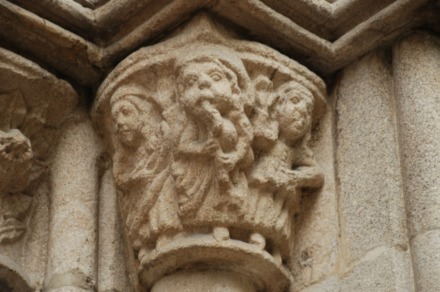
The bagpipe has been represented in iconography in the Iberian Peninsula since the eleventh century, frequently depicted as a rural instrument played by shepherds. The ethnographic evidence of the use of bagpipes in Portugal and Spain goes back to the nineteenth century. Variations of this instrument, designated gaita throughout the Iberian Peninsula, were documented in several regions, like the gaita gallega in Galicia (Spain), gaita asturiana in Asturias (Spain), or gaita-de-fole in Portugal, all situated in the North-West of the Iberian Peninsula. The designation gaita-de-fole refers specifically to the bagpipe in contrast with other wind instruments in the oboe family or in the flute and tabor family, also designated as gaitas. The generic term gaita-de-fole now used in Portugal corresponds to the original designation of instruments used in Terras de Miranda do Douro (in the North-East of the region of Trás-os-Montes) and in the bordering Spanish region of Zamora, considered as the most “archaic” Portuguese bagpipes. Throughout most of the twentieth century, the Northern regions of Trás-os-Montes and Minho, bordering with the Spanish regions of Galicia and Zamora, have been well known for their bagpiping tradition, as well as other areas of the North and Center of Portugal, including the regions of Douro Litoral, Estremadura, and Beira Litoral. Bagpiping has been documented mainly in rural areas, but also in the cities of Coimbra, Oporto and Lisbon (the capital of the country) and their surrounding areas.
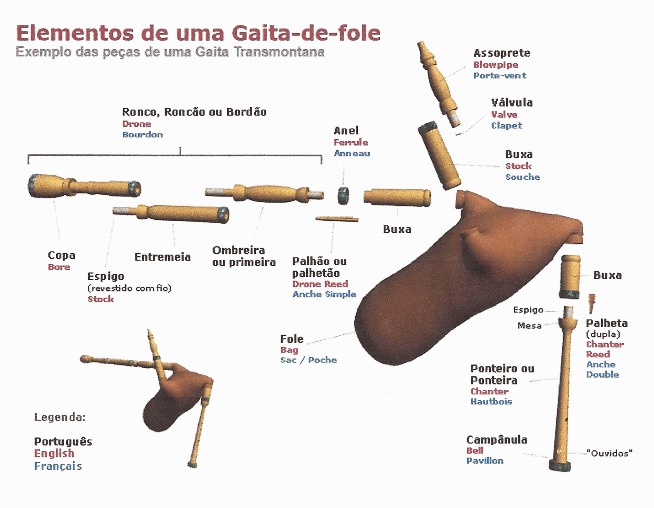
The gaita-de-fole consists of a chanter (a double-reed wooden pipe with eleven holes, eight of which are used to produce the melody), and one single-reeded large drone pipe that rests on the player’s left shoulder. Finally, through a blowpipe, the piper blows air into the bag, which is pressed under the player’s arm to provide a constant air supply to the melody and drone pipes. The chanter is played with three fingers of the left hand and four fingers of the right hand. Although the general designation used in Portugal is gaita-de-fole, regional designations are traditionally used (such as gaita transmontana, from Trás-os-Montes), and the term gaita galega is commonly used to refer to the bagpipes used in Minho, brought to different areas of Portugal by migrants from the bordering region of Galicia, or manufactured emulating the instruments used in that neighboring region of Spain. In some gaitas galegas a second or even a third drone is inserted into the bag.
Bagpipes traditionally used in the North-West of the Iberian Peninsula, including Northern Portugal, Galicia, Asturias, and Zamora, belong to the same category according to the classification system established by Anthony Baines. They all pertain to the Western European Bagpipes, which incorporates separate pipes: the chanter (double-reed) and the drone (single-reed), the air being blown by the bagpiper’s mouth. These bagpipes are also related to some of the most “archaic” European instruments: those which preserve a conical chanter and include only one drone, which Baines calls the “Atlantic” or “Celtic” bagpipes, usually accompanied by percussion, like the ones used in Galicia, Asturias, Northern Portugal, Scotland or Brittany.
The making of the gaitas-de-fole and gaitas galegas has changed through time, but they were traditionally made out of goatskin (for the bag) and wood. The tunings vary, usually hovering between A and C. The drone is tuned two octaves above the chanter. The gaita-de-fole used in a traditionally agro-pastoral society in Terras de Miranda do Douro was usually handcrafted with basic tools, evidencing the shape of the goatskin used as raw material for making the bag. Front legs and neck were used to attach the chanter, the blow pipe, and the drone pipe. The remaining skin was tied with a rope to close the bag in the opposite side.
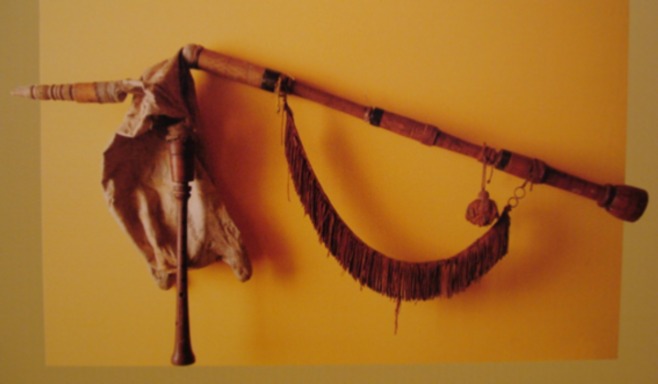
This bagpipe has a distinctive sound, which is often described by players and scholars as “deeper”, and more “melancholic” than other bagpipes traditionally used in Portugal. The scales tend to be diatonic, modal, and untempered, including microtonal notes. The melodies produced by the instrument are integrated within the traditional regional vocal and instrumental style. The performance style is characterized by the use of tremolos and embellishments in the melodies played on the chanter. Scholars, musicians and enthusiasts value this gaita-de-fole traditionally used in Terras de Miranda do Douro for its “archaism” if compared to the gaitas galegas or more developed instruments in terms of making, shape, sonority, repertoire and playing, used in other Portuguese regions and, above all, in Galicia and Asturias, where bagpiping was highly professionalized throughout the twentieth century.
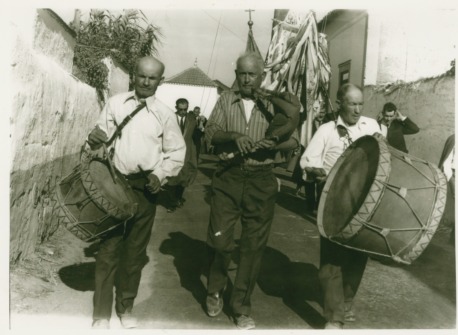
Having a powerful sound, the bagpipe has been mainly played in the open air. In Portugal, one or two male bagpipers and a variable number of drummers traditionally provided entertainment for feasts and celebrations. Ensembles called gaiteiros integrating bagpipe, snare drum and bass drum predominate. In the region of Minho, Zés-Pereiras include a larger number of percussionists. Occasionally bagpiping provided accompaniment for singing or coexisted with other traditional instruments, such as pipe and tabor, castanets, or shawms.
In Portugal, like in Spain, the bagpipe has traditionally been performed by professional or semi-professional musicians rather than by shepherds (depicted in historical iconography). For decades, each village had at least one well-known bagpiper, and genealogies of hereditary bagpipers are still perpetuated in some regions. These musicians provided music for religious and secular collective events: to accompany informal dancing, at weddings, fiestas, rites of passage or other community rituals, and pilgrimages, or to provide entertainment. Bagpipers also played a crucial role in celebrations such as liturgical ceremonies, religious rituals, processions, and parades.
Historical connections
In Portugal, bagpipe playing is historically related to similar practices in neighboring regions in the north of Spain, particularly in Galicia. This can be explained by cross-border exchange of bagpipers, instruments and repertories in the North of Portugal, and by the important presence in several regions of the country of migrants coming from Galicia. In Lisbon, a number of musical activities and feasts including bagpipes have been documented among Galician migrants since the nineteenth century.[1] The “Centro Galego de Lisboa” (Regional House of Galicia in Lisbon), founded in 1908, has promoted the playing of Galician traditional music including bagpiping, singing and dancing to reinforce the sentiment of attachment of migrant communities to their homeland. The promotion of Galician bagpiping in Lisbon contributed to the revival of the interest by the Portuguese community in their own bagpiping tradition, also connecting the cultural heritage of both the Galician and Portuguese populations.
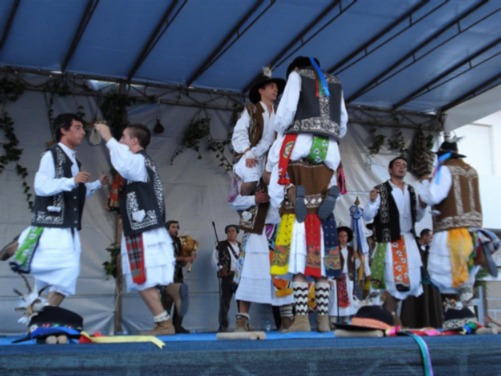
In the traditionally rural, isolated and underdeveloped area of Terras de Miranda do Douro (Trás-os-Montes), cultural and musical practices like bagpiping have been characterized by exchanges with the neighboring Spanish regions of Zamora, Galicia, and Asturias. Bagpiping has been traditionally cultivated in this area. It started to be promoted locally, nationally and internationally as a distinctive expression of Portuguese culture in the 1930s. In that decade, bagpipers started to accompany formally constituted folkloric groups of stick dances fostered by a local priest, António Maria Mourinho. These groups performed ritual dances called danças dos paulitos.
The frequent exchange of musical instruments and musicians in diverse celebrations between Galicia, Asturias, Zamora and Northern Portugal is evidenced by the number of music and dance repertoires associated to those regions played by Portuguese bagpipers, such as the laços (the typical repertory of the danças dos paulitos), jotas, muinheiras (emblematic Galician dance), carvalhesas, fandangos, alvoradas, or passacalhes.
A live tradition in different regions of Portugal during the first half of the twentieth century, bagpiping in the rural milieu decreased between the 1960s and 1980s, owing to modernization, mass migration, and profound socioeconomic and cultural transformations all over the country. The number of active local bagpipers and craftsmen diminished, and traditional handcrafted gaitas-de-fole started to be replaced with more sophisticated equally-tempered gaitas galegas manufactured in Galicia. In some cases, bagpipers were supplanted by other musicians and bands, or by recorded music. However, this musical tradition started to be revitalized and, since the 1990s, it was quickly disseminated to new rural and urban areas of Portugal, especially in regions of the North of the country and in the Metropolitan Area of Lisbon.
The revival of bagpiping in Portugal
The revival of the bagpipe took place in Portugal in the 1990s. The influence of similar revivals that took place decades earlier in other regions of the Iberian Peninsula, particularly in Galicia, was significant in this process.
In Galicia, the first revival of the bagpipe started in the nineteenth century, when this instrument was first vindicated as a regional emblem. A new revival movement started in the mid-1970s and consolidated since 1981, when Galicia gained its status as a Spanish Autonomous Region. A new model for the representation of Galician identity, culture, and music was then configured. Inspired by the transnational “folk music”, “Celtic music”, and later also “world music” movements, it emphasized Galicia’s difference from the rest of Spain. The bagpipe was widely popularized and projected as an iconic regional instrument. A number of musicians who recreated Galician music using Breton, Irish and Scottish models gained national and transnational reputation. The manufacturing of Galician bagpipes was improved. New, more sophisticated instruments with precise and diversified tunings were standardized, and the traditional ensembles often consisting of one or two bagpipes, snare and bass drum[2] gave place to new ensembles and bands including a variable number of bagpipers and percussionists playing together, some inspired by Scottish military pipe bands.
In Portugal, the revival of the bagpipe was driven by a number of individuals, groups, associations and institutions mainly in Trás-os-Montes and in the Metropolitan Area of Lisbon. They conceived bagpiping as a means to express themselves and develop their creativity, or to construct local identities and serve political and socio-economic aspirations (essentially in Terras de Miranda do Douro). The aim of the revival was, on the one hand, to preserve traditional bagpipes and their playing as an important element of Portuguese musical heritage, while claiming the incorporation of Portuguese expressions in the transnational community of bagpiping. On the other hand, following international trends and aesthetics, the aim was to explore the musical possibilities of the bagpipe in music productions within the domains of pop, rock, folk, “Celtic”, or “world music”.
In Lisbon, the Portuguese Bagpipe Society, founded in 1999, played an important role in the revival of bagpiping in Portugal by researching and disseminating the gaita-de-fole, promoting its construction and providing instruction for players. The number of musicians and groups dedicated to the preservation, making, playing and re-creation of the musical practice of the gaita galega and the gaita transmontana, integrated in diverse music ensembles and bands, rapidly spread in the Metropolitan Area of Lisbon and beyond thanks to a number of activities in which this society partook, including the organization of national gatherings of Portuguese bagpipers. Founders of the society were moved by the idea that traditional music, and particularly bagpipig, is an “authentic” expression of Portuguese culture that needs to be defended to avoid cultural homogenization in the context of increasing globalization. Since the 1980s, Paulo Marinho –on of the founders of the Portuguese Bagpipe Society- has been teaching bagpipe at the Centro Galego de Lisboa and other institutions, promoting its recognition as a traditional Portuguese musical instrument, contributing to its dissemination.
In Terras de Miranda do Douro (Trás-os-Montes), a renewed interest in bagpiping consolidated in the 1990s. The use of rural music and cultural expressions to vindicate local identity and promote tourism in order to overcome underdevelopment was then intensified, especially following the recognition by the Portuguese Government, in 1999, of the local language, mirandês, as Portugal’s second official language. Stick dances and the bagpipe, today taught in local schools, have been widely supported by municipal and regional entities ever since. Two local institutions, the Cultural Association Galandum Galundaina (founded in 1996) and the Centre for Traditional Music “Sons da Terra” (founded in 2002), played a crucial role in this area as mediators between the local population and governmental institutions, collecting, promoting and reinventing local cultural practices, organizing piping gatherings, contributing to the teaching of the bagpipe and to the constitution of rural and urban groups that recreate traditional music.
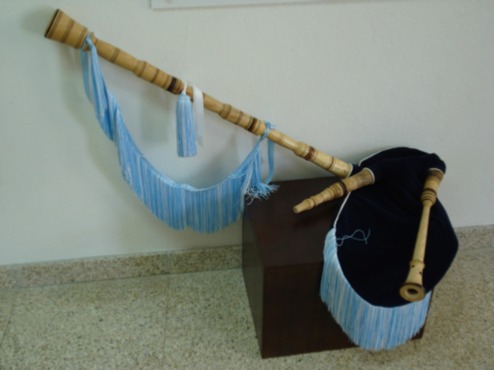
The revivalist activities carried out in Terras de Miranda do Douro and in the Metropolitan Area of Lisbon attracted Portuguese young people from urban and rural contexts. At the same time, in order to respond to the necessities and aspirations of contemporary musicians, instrument makers, and followers, the revival of the bagpipe in these and other regions of Portugal was accompanied by significant changes in the musical groups, instruments, instruction, playing techniques, repertoires and performance practice. Similarly to the changes introduced in the more sophisticated Galician bagpipes a few decades ago, the gaitas galegas and gaitas transmontanas now used in Portugal are made by professionalized makers.
Instruments used nowadays are lighter, more sophisticated, their sound being improved in terms of volume and timber, so different bagpipers can tune and play together, and the bagpipe can be integrated in diverse music ensembles.
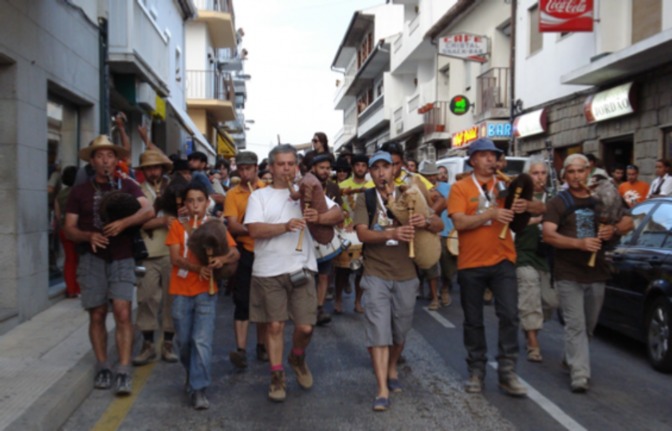
A number of pipe bands and ensembles inspired by bands founded in previous decades in Galicia and other Spanish regions emerged in cities and rural areas of Portugal since the 1990s, partly as a consequence of the need to play together in piping gatherings and of the new methods of collective training at schools and associations. Large bands similar to Galician pipe bands[3] that partake in cross-border concerts, contests and celebrations were constituted in localities in the north of Portugal since 1998.
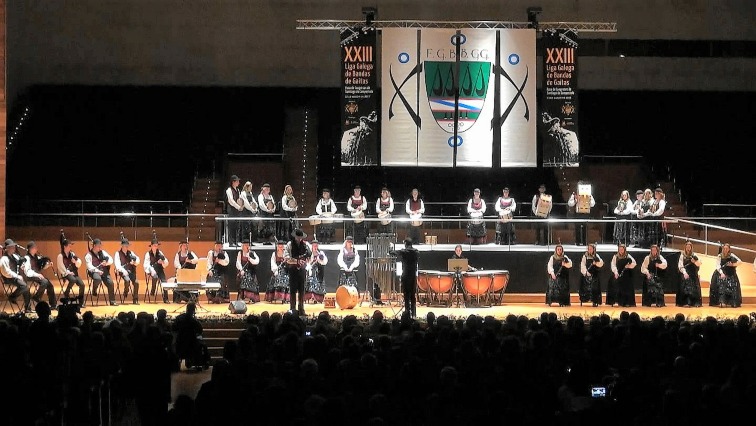
These bands are officially supported by local governments in an effort to promote bagpiping as a shared musical and cultural patrimony of Galicia and Portugal. They are regarded as innovative and prestigious music ensembles to provide music for local feasts and official events. In Terras de Miranda do Douro, while a number of new, larger ensembles emerged, the traditional gaiteiros consisting of a bagpiper accompanied by a snare and bass drum has continued to perform in religious and secular festivities and rituals, and to accompany local folklorized stick dances.
Some Portuguese musicians that were in charge of promoting and transmitting this tradition in their country in recent decades received training as bagpipers in Galician schools, and used gaitas galegas. A number of Portuguese instrument makers became specialized in the construction of gaitas galegas and gaitas transmontanas, but many musical instruments were ordered from Galician instrument makers or bought from their workshops. In Terras de Miranda do Douro, the gradual replacement of local bagpipes with gaitas galegas, and the search for more sophisticated musical instruments representative of local tradition triggered a project that culminated in the official recognition of a standardized gaita mirandesa by the Portuguese Ministry of Culture in 2007. This process was also inspired by the previous standardization of the Galician bagpipes.
Final remarks
Bagpipes used in Portugal have been conceived under two major categories: gaita-de-fole and gaita galega. The latter category reflects the influence, at least since the nineteenth century, of the instruments used in Galicia, a region internationally renowned for the revivals of the bagpipe that started in the nineteenth century and for the flourishing and development of bagpiping throughout the twentieth century. Bagpiping as cultivated in that region became a canonical model for Portuguese bagpipers. Cross-border exchanges, as well as the presence of Galician diasporic communities in several Portuguese regions promoted the connections of bagpiping in Galicia and Portugal. When the revival of this traditional practice started to consolidate in Portugal in the 1990s in urban and rural contexts, revivalists were inspired by previous processes which had taken place in Spain, especially in Galicia, fostering transformations in the instrument, its playing techniques, repertoires, and the music ensembles thriving in diverse areas of the country. The influence of the Galician model of bagpiping is also clear in Terras de Miranda do Douro (Trás-os-Montes), historically considered as the area of Portugal with the most “archaic” and “authentic” piping, where some of the “oldest examples” of bagpipes in the Iberian Peninsula were preserved.
[1] In the seventeenth century, a significant migratory influx from Galicia to Portugal, mainly to Lisbon and Porto, began. Since the nineteenth century, there are several references in the literature to the presence of Galicians in Portugal, and to their distinctive celebrations, including bagpiping. [2] In Galicia and West Asturias some quartets and quintets including bagpipes are documented since the nineteenth century. The Spanish army and other civilian institutions integrated this instrument in brass bands or founded pipe bands, thriving in Galicia since the early twentieth century. [3] This is the case of the bands of “Gaiteiros de Pitões de Júnias” (1998); “Gaiteiros de Lebução” (2003); “Gaiteiros da Fundação Maestro José Pedro” (2000) and “Banda de Gaitas de São Tiago de Cardielos” (2003) in the district of Viana do Castelo; and “Banda de Gaitas de São Bernardo” (2003) in the district of Aveiro.
BIBLIOGRAPHY
- Associaçao para o Estudo e Divulgaçao da Gaita de Foles (1999) Revista Gaita de foles 1. Lisboa: Associaçao para o Estudo e Divulgaçao da Gaita de Foles.
- Carvalho , Joao Soeiro de (2010) “Gaita-de-foles”. Enciclopédia da Música em Portugal no Século XX, Vol. 2, pp. 553-555. Lisboa: Círculo de Leitores.
- Cauffriez, Anne (1989) “La cornemuse du Tras-os-Montes (Portugal)”, Cahiers de Musiques Traditionelles 2, 165-182.
- García-Oliva, Alfonso (1992) Museo de la Gaita. Catálogo de las cornamusas del Museo de la Gaita de Gijón. Gijón: Fundación Municipal de Cultura.
- Jambrina Leal, Alberto (1988) “La gaita en Zamora y Tras os Montes”, Anuario de la Gaita, 37-38. Ourense: Escola Provincial de Gaitas. Deputación de Ourense.
- Oliveira, Ernesto Veiga de (1982/1966) Instrumentos musicais populares portugueses. Lisboa: FCG.
- Rodrigues, Juan-Gil López (2010) “Galiza em Portugal, música da”. Enciclopédia da Música em Portugal no Século XX, Vol. 2, pp. 557-559. Lisboa: Círculo de Leitores.
- Simões, Dulce (2012) “Entre a tradição e a modernidade. As bandas de gaitas no Norte de Portugal”. Anuario da Gaita 27, 58-61. Ourense: Escola Provincial de Gaitas. Deputación de Ourense.
Susana Morneno Fernández
University of Valladolid (Spain)
By Anon Fernández, Susana Moreno Trad
From Chanter Summer 2017.
- Data Processing Notice (GDPR)
@BagpipeSociety on X (formally known as Twitter)
TheBagpipeSociety on Instagram
 BagpipeSociety on Facebook
BagpipeSociety on Facebook
Something wrong or missing from this page? Let us know!
